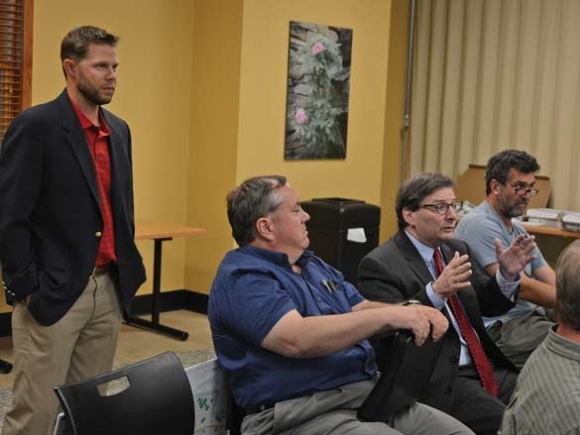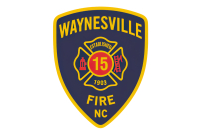Permit denied for Cullowhee development

A controversial request to build a 388-bed student housing complex on South Painter Road in Cullowhee was denied this week following a three-hour hearing before the Cullowhee Community Planning Council, but the decision could be tested if the developer opts to challenge it in court.
“Those standards that were denied, all I heard was, ‘I don’t like it,’” said Gary Miller, attorney for Atlanta-based developer Mallory & Evans, following the vote. “I didn’t hear any objective criteria that was introduced to support those decisions. So it seems to me that those are arbitrary, capricious, in the class of a lawsuit setting.”
“In regard to each one of them we might not all agree on them but ….” said County Attorney Heather Baker.
“But they have to have evidence beyond, ‘My personal gut is it doesn’t feel good,’ Miller said. “There was a traffic study introduced that stated by DOT’s (the N.C. Department of Transportation’s) standards they did everything they had to do. There was nothing introduced on the negative side of that. So I’m just confused as to how decisions were made when there was nothing introduced to support those conclusions.”
“I understand,” said Heather Baker. “They’ve made their decision and I think you’re to your final vote.”
“So at this point,” said Chairman Scott Baker, “it’s just a formality of the decision based on one through seven that …”
Related Items
“Mr. Chairman I would respectfully request that you reconsider the denial based on the basis that there was no evidence to support your denials,” said Miller.
“I appreciate your input,” Scott Baker said, “and I think at this point we’ve gotten through these items and I think there’s a process if you disagree with that.”
Community concerns
Mallory & Evans had wanted to build a gated townhome development for Western Carolina University students on an 11.6-acre piece of property along South Painter Road in Cullowhee. The housing complex was to include 97 units in 12 buildings, with a total of 388 bedrooms. The company’s principal, Brantley Basinger, told the Cullowhee Council that the development would provide in-demand housing for WCU students while also prioritizing student safety and collaboration with the community.
However, the proposal has been fraught with public opposition. The narrow, winding roads in the area just north of campus weren’t built to handle the increasing student population of the Cullowhee area, with a flurry of newer developments on Ledbetter Road — South Painter and Ledbetter both feed into Monteith Gap Road — creating conflicts between drivers, cyclists and pedestrians. There are no sidewalks in the area. The problem culminated with the death of pedestrian Daniel Brown in 2016 following a hit-and-run by a WCU student.
The proposed development could inject nearly 400 more cars to this situation, and while the developer offered to build a sidewalk to South Painter’s intersection with Monteith Gap, pedestrians would have nowhere to go from there. As the crow flies, it’s just over half a mile from the site to campus, but that’s not a walkable path. Building a greenway connector to campus would require crossing five to 10 private properties, depending on the route.
“It’s so sad to be that close and have to depend on a vehicle to get me there because I can’t ride my bike or walk, and it really concerns me greatly the congestion of people trying to get to the back door of campus and on around to all the other things off Ledbetter and South Painter,” said Myrtle Schrader, a member of the Cullowhee Council.
Currently, South Painter Road contains 15 developed properties, including a 42-person apartment complex. The area is within the Cullowhee Planning Area — the zoning regulations were approved in 2015 after an extensive public input process — and zoned such that any development with more than 40 units must receive a special use permit from the Cullowhee Council. The proposed development calls for 97 units.
“Who in this room would be pleased about a 388-bed complex with primarily college students next door?” asked Sarah Fortwendel, who has lived on the property next to the proposed development for 23 years with her husband Clete.
She told the council that she was concerned that visitors might park along the street or in her yard, as the community was to be gated. Conducting her own traffic study, she said, she counted an average of 60 vehicles per day along South Painter and was worried about adding 400 more to that number.
“This will be a traffic hazard and endanger public safety,” Fortwendel said. “The only entrance or exit is on South Painter Road. Trying to turn left onto South Painter Road currently is quite difficult and results in much hornblowing, close calls and even being flipped off and cursed at.”
“I think this is a bad idea, the way it’s set up,” added Clete Fortwendel. “It probably could be changed and arranged differently. I’m not anti-growth, I’m not anti-development, but I am pro-control. I’d like to see more controls. I’d like to see more of the developments committing themselves to this community rather than coming in and looking at Jackson County as a cash cow.”
Adam Bigelow, a Cullowhee resident and director of the Cullowhee Community Garden, said that he was concerned that the new impervious surface would increase flooding in an already floodprone area. He said the development would make more sense if it included a way for students to cross the creek and walk to campus.
“I don’t want to see more college kids walking on that road,” agreed Chris Bogardus, who lives on nearby Searcy Mountain Road. “If they do do this development — and I am for it — I think they need to put a footbridge over Cullowhee Creek so that the college kids can get over the creek, go over the hill and be in the college without getting in their cars.”
Navigating the standards
While the meeting included opportunity for public comment, councilmembers were instructed to not take opinions into consideration when making their decision. The proceeding was a quasi-judicial hearing, meaning that the Cullowhee Council presided over a courtlike hearing in which evidence was presented to prove whether the proposal met the six standards required for approval. The council then had to vote on each standard separately based only on the evidence presented — not on public comment or their own opinions and experiences.
Evidence presented came mainly from the developer and the experts it had engaged to complete engineering and traffic studies. Otherwise, the only testimony presented came from the county’s senior planner, John Jeleniewski. Jeleniewski presented the staff report on the application, which concluded with a recommendation that the council approve the request under the condition that final site plans comply fully with the Cullowhee planning ordinance.
Of the six standards required to green-light the development, the ones pertaining to traffic and safety were perhaps the most contested in the public sphere. In order to grant the permit, the council would had to have found that the development “will not cause undue traffic congestion or create a traffic hazard” and that it “will not materially endanger the public health or safety.”
According to a traffic study completed by Waynesville-based J.M. Teague Engineering, the development would not adversely impact traffic congestion. To complete the report, Mark Teague conducted a 24-hour traffic count along the road April 5 to determine the baseline traffic, increasing the number by 2 percent to account for growth over the year between then and when the development could come online. He then projected what the level of traffic would be if all 388 tenants drove it each day.
“The long and short of it is this project is not going to negatively impact the roads,” Teague said.
At DOT’s direction, he studied only the intersection of South Painter and Monteith Gap roads — not the intersection of Monteith Gap and Old Cullowhee or the length of South Painter and Monteith Gap heading out to Old Cullowhee. According to Basinger, they asked to study the Monteith Gap/Old Cullowhee intersection as well, but DOT said it would not be affected. While DOT said the roads could handle the increased traffic, it asked that turning lanes be added at the entrance to the site and on Monteith Gap turning on to South Painter.
However, councilmembers had some concerns about the results of the study. For instance, the study puts the number of cars using Monteith Gap Road at 4,000 per day, but that’s a 2014 number and therefore doesn’t include traffic from the recently constructed 500-bed Riverwalk complex.
“Did any of you go out and walk South Painter Road or walk Monteith Gap or ride a bicycle during peak traffic hours?” asked Scott Baker.
“I’ve walked pieces of it, yes, several times, and I’ve also witnessed several pedestrians walking as well as bicycling,” Basinger answered.
“What would your assessment be of the safety factor of walking that road?” Baker asked.
“I would tell you that based on that area it’s probably the safest portion of the area for any student development that’s previously up there on Ledbetter Road,” Basinger answered.
Several members of the council expressed skepticism about the traffic study’s conclusion, and especially about the finding that adding 388 residents to the road wouldn’t impact traffic safety.
“It’s a mess now and very dangerous,” said Councilmember Jim Lewis. “I can’t see how 388 cars makes it the same.”
They also balked at Basinger’s assertion that the development wouldn’t result in students parking alongside the road rather than inside the gated community. Plans call for 418 parking spots — 30 more than the number of potential residents — and while the number meets zoning requirements, some were concerned it wouldn’t be enough.
“Rumor has it from time to time there’s some alcohol involved in student housing too,” Bennett said. “So I don’t see enough parking for your complex.”
“This is more parking than we have at any of our other complexes,” Basinger replied. “Most of our other complexes are 1:1 and we’ve never had a problem at any of our other complexes.”
The vote
When it came time to vote on the six standards, the mood turned even more serious than it had been in the earlier part of the proceeding, with the word “struggle” coming up time and again as councilmembers talked through the decisions.
For instance, on the second standard — the one requiring the development be “reasonably compatible with significant natural and topographic features on the site” — Schrader had trouble with the word “natural.”
“I struggle with ‘significant natural and topographical features,’” she said. “I think that is a matter of interpretation because that’s not natural.”
“Right, and I think the question would be talking about the evidence presented,” said Planning Director Michael Poston.
“I understand that, but I’m just saying what is natural now and what’s proposed, I don’t think that jives,” Schrader replied.
She wound up voting no on that standard, along with Bennett and Lewis, making it a split vote. Under the rules for a quasi-judicial hearing, a split vote is a no.
The struggle returned for the vote on the sixth standard, the one requiring that the development not cause “undue traffic congestion or create a traffic hazard.”
“I still struggle with the numbers a little bit on this one,” Scott Baker said.
“I don’t really feel like this development is creating the traffic hazard,” said Councilmember Joel Setzer, who was formerly the division engineer for the DOT. “I think the biggest traffic hazard is the vehicle-pedestrian conflicts along the road, and I don’t think the additional cars are creating the hazard. They’re not helping it. But I don’t think they’re creating it.”
Throughout the conversation, Heather Baker reminded councilmembers that they could only consider the evidence presented, not their own opinions or experience. In some cases this proved difficult, as most members of the council had lived in the area for decades. While realities such as Brown’s pedestrian death in 2016 weren’t part of the testimony, they were certainly on the minds of the decision-makers.
“It’s been a problem. We had a death before,” Bennett said. “We’re trying to make an emergency solution with Ledbetter Road, which is not taking into consideration this new development. I can’t throw that out because whether it’s evidence or not I live here and I’m part of it.”
When the hearing ended, councilmembers took a few minutes to debrief the situation before adjourning the meeting.
“I really appreciate how hard this is, and I appreciate how much work y’all do and how you’re trying to balance everything,” Schrader said to the county employees in attendance, “and I just want to honor you with respect to the position that you’re willing to do this hard job … My biggest sadness is that we’re not a government, that we really have no power in Cullowhee.”
Something has to change, Bennett said.
“I’d like to ask our planning director, our county manager, our board of commissioners to get with the administration of Western Carolina University and solve this student housing issue before it ruins more communities,” he said. “We’ve destroyed three other communities already. Go to Briar Patch or Speedwell Road or anything else, and I think there ought to be a plan to stop that.”
Following the denial, Mallory & Evans can’t reapply for at least a year, unless the Cullowhee Council waives the waiting period.
How they voted
Councilmembers voted separately on each of the six standards needed to approve the permit. A no on any one standard was sufficient to deny the permit, and the vote was no on two standards.
Proposed use will not materially endanger public health or safety. (6-1, yes)
• Yes: Rick Bennett, Scott Baker, Jack Debnam, Myrtle Schrader, Joel Setzer
• No: Jim Lewis
Proposed use is reasonably compatible with significant natural and topographic features on the site and within the immediate vicinity of the site. (3-3, no)
• Yes: Scott Baker, Jack Debnam, Joel Setzer
• No: Rick Bennett, Myrtle Schrader, Jim Lewis
Proposed use will not substantially injure the value of adjoining properties. (4-2, yes)
• Yes: Scott Baker, Jack Debnam, Joel Setzer, Myrtle Schrader
• No: Rick Bennett, Jim Lewis
Proposed use is in harmony with the scale, bulk, coverage, density and character of Cullowhee. (5-1, yes)
• Yes: Rick Bennett, Scott Baker, Jack Debnam, Myrtle Schrader, Joel Setzer
• No: Jim Lewis
Proposed use is appropriately located with respect to transportation, water, fire/police protection, waste disposal and similar facilities. (6-0, yes)
• Yes: Rick Bennett, Scott Baker, Jack Debnam, Myrtle Schrader, Joel Setzer, Jim Lewis
• No: None.
Proposed use will not cause undue traffic congestion or create a traffic hazard. (4-2, no)
• Yes: Jack Debnam, Joel Setzer
• No: Rick Bennett, Scott Baker, Myrtle Schrader, Jim Lewis









